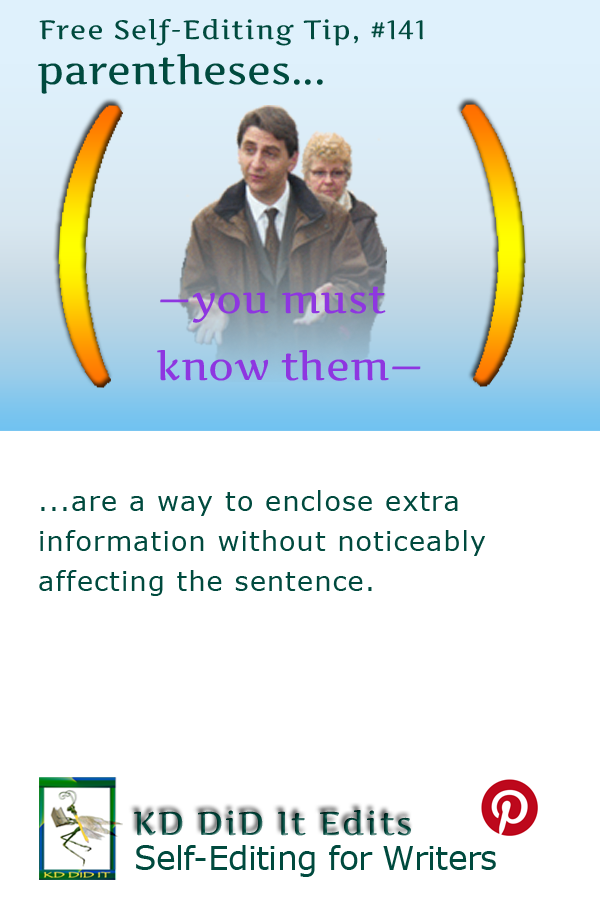Revised as of
24 Mar 2023
While it is useful to know how to use parentheses within a sentence, the most common problems writers encounter is how to punctuate when parentheses are involved.
Other interrupter posts include “Interrupter“, “Brackets“, “Em, 2-Em, & 3-Em Dashes“, and technically, “The Mystery of the Comma and the Vocative Case“.
The Properly Punctuated explores . . .
. . . the proper use of quotation marks, commas, semicolons, colons, ellipsis, etc., including how to properly mark dialog, ahem. As Properly Punctuated is in no way complete, I would appreciate suggestions and comments from anyone on punctuation with which you struggle or on which you can contribute more understanding.
If you found this post on “Parentheses” interesting, consider subscribing to KD Did It, if you’d like to track this post for future updates.
| Parentheses (Parenthesis is the singular) |
|||
| Punctuation: ( ) | |||
| Definition: A pair of signs used in writing to mark off an interjected explanatory or qualifying remark without otherwise affecting the sentence. They may also be used to indicate separate groupings of symbols in mathematics and symbolic logic, etc.
Rule: Enclose short selections of interrupting elements that add information or identification that generally minimize the emphasis to the separated text. |
|||
| The National Rifle Association (NRA) has a strong lobby in Washington.
I walked right up to him (nobody was with him at the time) and told him what we had decided. |
|||
| Rule: Enclose figures or letters when used for in creating a list within a sentence. | |||
| Each essay will be judged on the basis of its (a) length, (b) artistic merit, and (c) originality.
NOTE: You could also use a) or 1). |
|||
| Contemporary Rule: Parentheses placed before and after an interrupter when used in the middle of a sentence. | |||
| Queen Victoria was (as they say) a formidable woman.
So let’s beat back this unnecessary, unfair and (let’s not mince words) cruel attack on working Americans. |
|||
| Punctuating with Parentheses | |||
| Back-to-Back Parentheses (xx) (xx) |
Rule: APA: Do not use back-to-back parentheses. Include everything in one set and use a semicolon to separate the the information. Chicago: Do use back-to-back parentheses (with a space in between) if they enclose entirely unrelated material |
||
|
Return to top or post contents |
APA: There are various leadership theories (e.g., chaos, relational; Northouse, 2006)
Chicago: There are various leadership theories (e.g., chaos, relational) (Northouse, 2006). |
||
| Comma Placed After Ending ) | Rule: In a series, the comma is after the ending parenthesis | ||
|
Return to top or post contents |
I picked up a Bernard Cornwell, the latest David Weber (it’s an Honor Harrington!), and a Laurell K. Hamilton. | ||
| Ending Punctuation is Outside () | Rule: At the end of the sentence, the period / question / exclamation mark is outside the ending parenthesis. | ||
|
Return to top or post contents |
Derek asked me out (but he’s such a jerk). | ||
| Ending Punctuation is Inside () | Rule: Encloses a complete sentence, the ending punctuation is inside the ending parenthesis. | ||
|
Return to top or post contents |
Derek asked me out. (He is such a jerk.) | ||
| Multiple Sentences in () | Rule: Within a sentence AND the enclosed parenthetical text is more than one sentence, punctuate everything but the last sentence (inside the parentheses). | ||
| The instructions (Place tab A in the slot. Leave tab B alone) were confusing.
I bought eggs, celery (which was a little wilted), and crackers. I hope (for everyone’s sake) that my explanation makes sense! Credit to: Lakin |
|||
C’mon, get it out of your system, bitch, whine, moan . . . which words are your pet peeves? Also, please note that I try to be as accurate as I can, but mistakes happen or I miss something. Email me if you find errors, so I can fix them . . . and we’ll all benefit!
Satisfy your curiosity about other Properly Punctuated posts on its homepage or more generally explore the index of self-editing posts. You may also want to explore Book Layout & Formatting Ideas, Formatting Tips, Grammar Explanations, Linguistics, Publishing Tips, Word Confusions, Writing Ideas and Resources, and Working Your Website.
Resources for Parentheses
Lakin, C.S. “Say What?” Live Write Thrive. 20 Apr 2012. Web. 3 Dec 2014. <https://www.livewritethrive.com/?s=parentheses>.
“Use an Apostrophe.” “Use a SEMICOLON.” “PUNCTUATION.” Towson.edu. n.d. Web. 3 Dec 2014. <http://www.towson.edu/ows/punct2.htm#apostrophe>.
Pinterest Photo Credits
This is Kathy’s own work with help from the katydid’s friends.


